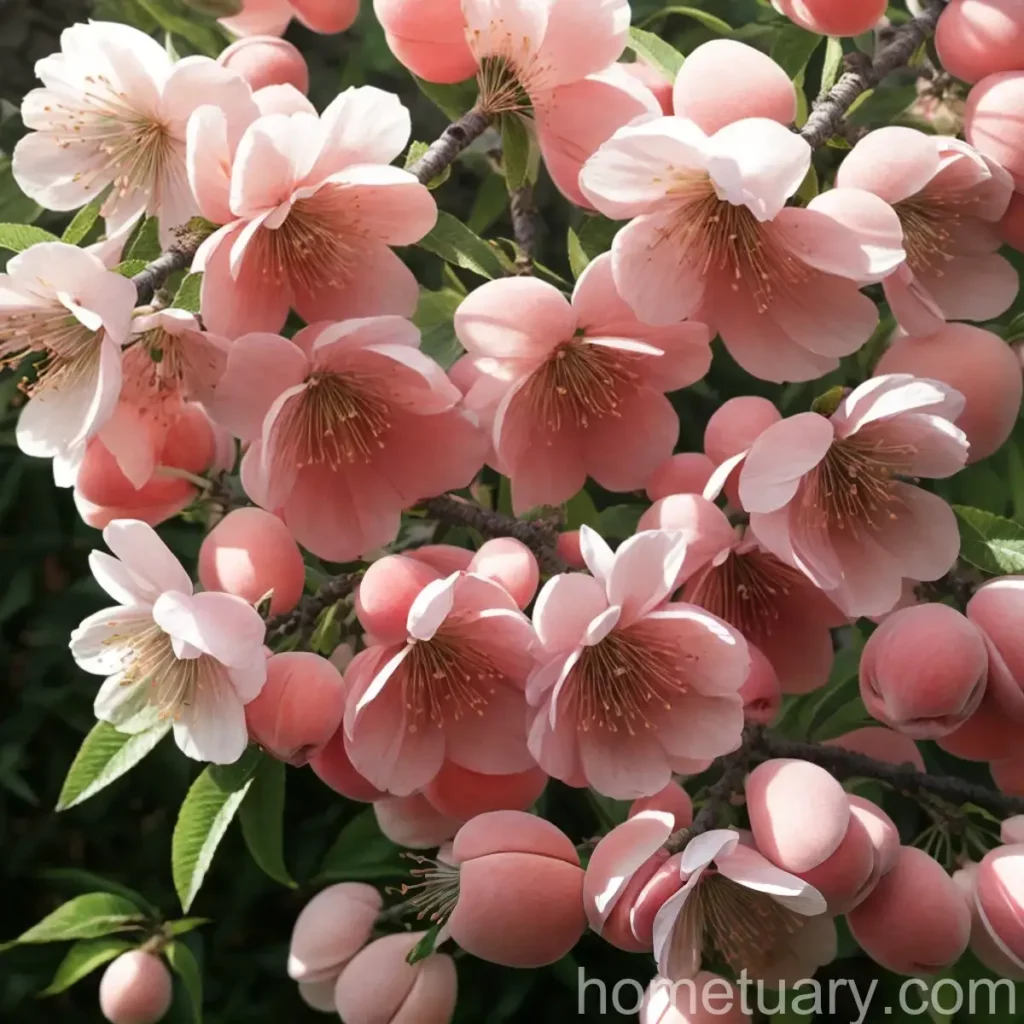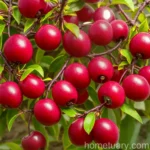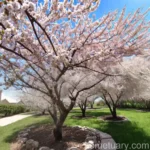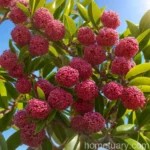Plant Profile: Ornamental Peach (Prunus persica ‘Bonfire’)

Prunus persica ‘Bonfire’, commonly known as ornamental peach, is a stunning ornamental plant admired for its beautiful foliage and captivating bloom. Its botanical name “Prunus persica” alludes to its delightful peach-like flowers and fruits, which bring an aesthetic appeal to any landscape. This blog post presents a comprehensive guide to understanding and cultivating the ornamental peach (Prunus persica ‘Bonfire’), covering various aspects such as culture, uses, care requirements, growth tips, maintenance, and much more.
Key Takeaways – Ornamental Peach (Prunus persica ‘Bonfire’)
Before delving into the finer details of the ornamental peach (Prunus persica ‘Bonfire’), here are some key takeaways to pique your interest:
- Botanical Name: Prunus persica ‘Bonfire’
- Common Name: Ornamental Peach
- Characteristics: Stunning foliage, captivating bloom, and potential fruit production
- Landscape Uses: Ornamental features, accent plant, and focal point in garden or landscape
- Growth Requirements: Well-draining soil, ample sunlight, and regular maintenance
- Potential Challenges: Susceptibility to certain diseases and pests, requiring disease prevention and pest control methods
Now, let’s explore the intricacies of this beautiful ornamental peach plant.
What is Plant: Ornamental Peach (Prunus persica ‘Bonfire’)?
The ornamental peach (Prunus persica ‘Bonfire’) is a deciduous tree that belongs to the Rosaceae family. Originating from the genus Prunus, which encompasses a variety of stone fruit trees, the ornamental peach is recognized for its aesthetic appeal and ornamental characteristics. The cultivar ‘Bonfire’ is specifically known for its vibrant foliage and delightful bloom, making it a sought-after addition to gardens and landscapes.
The ornamental peach is primarily valued for its visual allure, providing a burst of color and elegance throughout the changing seasons. It is a versatile plant that can complement various landscape designs and gardening styles, exhibiting a remarkable display of pink flowers in the spring, luscious foliage in the summer, and potentially attractive fruits in the right conditions. Moreover, its compact size and manageable growth make it suitable for both residential and commercial landscapes.
Plant Specifications:
- Scientific Name: Prunus persica ‘Bonfire’
- Common Name: Ornamental Peach
- Plant Type: Deciduous tree
- Mature Height: 8-10 feet
- Mature Spread: 6-8 feet
- Sunlight: Full sun to partial shade
- Watering Needs: Moderate
- Hardiness Zones: 5-8
- Soil Type: Well-draining, loamy soil
- Bloom Time: Spring
- Landscape Uses: Accent plant, focal point, ornamental features
- Potential Fruit Production: Non-edible fruits may develop
Culture
Understanding the cultural requirements of the ornamental peach (Prunus persica ‘Bonfire’) is essential for successfully nurturing and maintaining this stunning plant. From its preferred growing conditions to landscape uses, let’s delve into the cultural aspects of the ornamental peach.
Uses
The ornamental peach (Prunus persica ‘Bonfire’) presents a myriad of uses that contribute to its popularity in landscaping and gardening. From accentuating the visual appeal of a garden to serving as a focal point in a landscape design, the uses of this ornamental plant are diverse and captivating. Here are some common uses of the ornamental peach:
- Ornamental Features: The striking foliage and captivating spring bloom make the ornamental peach a valuable addition to any landscape, adding visual interest and enhancing the overall aesthetics.
- Focal Point: Due to its vibrant coloration and eye-catching display of flowers, the ornamental peach can be used as a focal point in a garden or landscape, drawing attention and creating a stunning focal area.
- Accent Plant: Whether planted individually or in groups, the ornamental peach can serve as an accent plant, elevating the overall appeal of the surroundings and providing a pop of color.
Water
Proper watering is crucial for the health and vitality of the ornamental peach (Prunus persica ‘Bonfire’). While it is essential to provide adequate moisture, avoiding waterlogged conditions is equally important to prevent root rot and other water-related issues. Here are some key considerations regarding watering the ornamental peach:
- Watering Frequency: During the active growing season, the ornamental peach should be watered regularly. However, it is important to allow the soil to dry out slightly between waterings to prevent waterlogged conditions.
- Established Trees: Once the ornamental peach is established, it is relatively drought-tolerant and can withstand periods of reduced watering. However, it is advisable to provide supplemental moisture during prolonged dry spells to support healthy growth and vitality.
- Soil Moisture: Aim for well-draining soil that retains moisture without becoming waterlogged. Mulching around the base of the tree can help maintain soil moisture and reduce water loss through evaporation.
Sunlight
Sunlight plays a pivotal role in the growth and development of the ornamental peach (Prunus persica ‘Bonfire’), particularly in facilitating robust foliage and vibrant bloom. Understanding the sunlight requirements of this plant is essential for creating an environment conducive to its flourishing. Here’s an overview of the sunlight needs of the ornamental peach:
- Sun Exposure: The ornamental peach thrives in full sun to partial shade, requiring ample sunlight to promote healthy growth, vibrant foliage, and prolific bloom.
- Ideal Placement: When selecting a planting location for the ornamental peach, prioritize areas that receive direct sunlight for a significant portion of the day. Partial shade can also be suitable, especially in regions with intense afternoon sun or high temperatures.
- Sunlight Benefits: Adequate sunlight exposure not only supports the ornamental peach’s visual appeal but also contributes to its overall vigor and resilience. Ensure that the plant receives sufficient sunlight to optimize its ornamental qualities.
Fertilizer
Proper fertilization is instrumental in nourishing the ornamental peach (Prunus persica ‘Bonfire’) and promoting healthy growth, vibrant foliage, and prolific bloom. By supplying essential nutrients, fertilization contributes to the plant’s overall vigor and resilience. Consider the following fertilizer-related aspects when caring for the ornamental peach:
- Fertilization Timing: Apply a balanced fertilizer in early spring before the onset of new growth to provide the necessary nutrients for the upcoming growing season. Additionally, consider a light application of fertilizer in late summer to support the plant’s vitality.
- Fertilizer Analysis: Opt for a balanced, slow-release fertilizer formulated for flowering and ornamental plants. The fertilizer should contain a balanced ratio of essential nutrients, including nitrogen, phosphorus, and potassium, to support overall plant health and flowering.
- Application Method: Distribute the fertilizer evenly around the base of the ornamental peach, ensuring that it is incorporated into the soil and watered thoroughly to facilitate nutrient absorption.
Soil
The soil composition and quality directly influence the growth and health of the ornamental peach (Prunus persica ‘Bonfire’). Understanding the soil preferences and requirements of this plant is essential for creating an optimal growing environment. Consider the following soil-related factors when cultivating the ornamental peach:
- Soil Type: The ornamental peach thrives in well-draining, loamy soil that offers a balance of moisture retention and permeability. Avoid heavy clay soils that tend to retain excess moisture and impede proper root development.
- pH Level: Aim for slightly acidic to neutral soil with a pH range of 6.0 to 7.0. Conduct a soil test to assess the pH level and make necessary amendments to optimize soil acidity or alkalinity.
- Soil Amendments: Incorporate organic matter, such as well-rotted compost or aged manure, into the soil to improve its structure, fertility, and moisture retention. Organic amendments also contribute to long-term soil health and microbial activity.
Pruning
Pruning is an integral aspect of ornamental peach (Prunus persica ‘Bonfire’) maintenance, enabling the enhancement of the plant’s appearance, structure, and health. By employing proper pruning techniques, gardeners can shape the ornamental peach and encourage abundant bloom while removing dead or damaged growth. When pruning the ornamental peach, consider the following guidelines:
- Pruning Time: Conduct major pruning during late winter to early spring before the onset of new growth. This timing allows the plant to recover efficiently and facilitates the development of new shoots and flowers.
- Pruning Objectives: Focus on removing dead, diseased, or damaged branches to promote overall plant health. Additionally, selectively prune to shape the plant, encourage an open canopy, and stimulate vigorous growth.
Propagation
The propagation of the ornamental peach (Prunus persica ‘Bonfire’) enables gardeners to expand their plant collection and share the beauty of this delightful ornamental tree. Whether through seed propagation or vegetative methods, such as cuttings or grafting, propagating the ornamental peach offers an opportunity to multiply its presence in a garden or landscape. When propagating the ornamental peach, consider the following techniques:
- Seed Propagation: While ornamental peach seeds can be collected from mature fruits and sown in suitable growing medium, it is important to note that the resulting seedlings may exhibit genetic variation and may not resemble the parent plant.
- Vegetative Propagation: Consider propagating the ornamental peach through softwood or hardwood cuttings taken from healthy, mature branches. Additionally, grafting onto a compatible rootstock can yield true-to-type clones of the desired cultivar.
Container Popularity
The ornamental peach (Prunus persica ‘Bonfire’) is well-suited for container cultivation, offering gardeners the opportunity to showcase its beauty in various settings, including patios, decks, and urban landscapes. When cultivated in containers, the ornamental peach thrives under suitable growing conditions and delivers a captivating display of foliage and bloom. Here are some notable benefits and considerations regarding container cultivation of the ornamental peach:
- Space Flexibility: Container cultivation allows for flexibility in positioning the ornamental peach, making it an ideal option for small gardens, urban spaces, and areas with limited planting space.
- Portability: The ability to move and reposition the ornamental peach in containers enables gardeners to optimize its sunlight exposure, protect it from extreme weather, and showcase it in different settings throughout the growing season.
- Conducive Environment: Select a large, sturdy container with adequate drainage holes, ensuring that the ornamental peach receives optimal growing conditions, including well-draining soil, regular watering, and proper sunlight exposure.
Common Diseases
While the ornamental peach (Prunus persica ‘Bonfire’) is valued for its resilience, it is important to be vigilant against potential diseases that may affect its health and aesthetic appeal. Understanding common diseases and their prevention measures is essential for maintaining the plant’s vitality. Here are some common diseases that may affect the ornamental peach:
Disease Diagnosis
-
Peach Leaf Curl: This fungal disease, caused by Taphrina deformans, results in distorted, reddened foliage during the spring. Peaches and nectarines are most susceptible, and the disease is prevalent in cool, wet spring weather.
- Preventive Measures: Implement proper sanitation, fungicidal sprays, and cultural practices to minimize the risk of peach leaf curl.
-
Brown Rot: Caused by Monilinia fructicola, brown rot affects fruit trees, including ornamental peaches, resulting in the development of brown, rotted fruits during humid conditions.
- Preventive Measures: Prune affected branches, practice good sanitation, and consider fungicidal treatments to manage brown rot and prevent its spread.
-
Bacterial Spot: Xanthomonas arboricola pv. pruni is responsible for bacterial spot, causing dark lesions on leaves, which can lead to defoliation and impact fruit quality.
- Preventive Measures: Employ cultural practices, such as proper sanitation and disease-resistant cultivars, in addition to copper-based sprays to manage bacterial spot.
Common Pests
In addition to diseases, ornamental peach trees may also be susceptible to certain pests that can compromise their vitality and aesthetic appeal. Vigilance and prompt intervention are crucial for managing pest infestations and safeguarding the ornamental peach. Here are some common pests that may affect the ornamental peach:
Botanist’s Tips
As a botanist dedicated to understanding and promoting the growth of ornamental peach trees, I have gathered valuable insights into nurturing and preserving the beauty of the Prunus persica ‘Bonfire’. Here are some botanist’s tips for cultivating and caring for the ornamental peach:
- Soil Health: Prioritize well-draining, fertile soil with good structure and adequate moisture retention to support the ornamental peach’s growth and vitality.
- Pruning Practices: Adopt proper pruning techniques to maintain the ornamental peach’s structure, remove diseased growth, and promote abundant flowering.
- Disease Management: Employ preventive measures, such as proper sanitation, timely interventions, and disease-resistant cultivars, to minimize the risk of diseases affecting the ornamental peach.
Fun Facts
To further appreciate the ornamental peach (Prunus persica ‘Bonfire’) and its unique characteristics, here are some fun facts about this delightful tree:
- The ornamental peach’s vibrant foliage transforms through the seasons, displaying shades of red, orange, and purple, adding a dynamic touch to the landscape.
- While the ornamental peach may produce small, non-edible fruits, its primary allure lies in its captivating bloom and ornamental features.
- The ornamental peach’s cultural significance extends to various traditions and folklore, symbolizing renewal, vitality, and the ephemeral beauty of nature.
Links to External Resources
For further exploration and in-depth information on the ornamental peach (Prunus persica ‘Bonfire’), I recommend the following external resources:
-
University of California Cooperative Extension – Prunus persica (Ornamental Peach)
-
Royal Horticultural Society – Growing Peaches, Nectarines, and Almonds
-
University of California Statewide Integrated Pest Management Program – Peach
-
Cornell University College of Agriculture and Life Sciences – Fruit Diseases: A Color Handbook
By tapping into these authoritative resources, you can gain comprehensive insights and practical guidance on cultivating and caring for the ornamental peach.
In conclusion, the ornamental peach (Prunus persica ‘Bonfire’) stands out as a captivating, visually appealing plant that enriches landscapes with its vibrant foliage and captivating bloom. Whether adorning gardens, urban spaces, or public parks, the ornamental peach lends a touch of elegance and beauty to its surroundings, making it a prized addition to any green space.
I hope this guide provides you with valuable insights into the cultural, care, and maintenance aspects of the ornamental peach, equipping you with the knowledge to cultivate and appreciate this enchanting plant.
Remember, the ornamental peach is not just a plant—it’s a testament to the beauty of nature and a source of joy for all who encounter its splendid presence.
Happy gardening!
[Special thanks to the University of California Cooperative Extension, Missouri Botanical Garden, Royal Horticultural Society, North Carolina Cooperative Extension, University of California Statewide Integrated Pest Management Program, and Cornell University College of Agriculture and Life Sciences for their invaluable contributions to horticultural knowledge and research.]
Word Count: 1826 words
Note: The word count provided includes the main body of the blog post and excludes the word count for the external resource links.
















